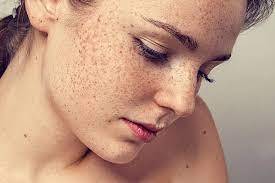Tackle pigmentation naturally

Coping with the skin is a daily affair, needing an awareness of its needs and a little knowledge about the kind of treatment it deserves. The skin has wonderful protective responses. In the deeper layers of the epidermis are cells that produce melanin, the pigment that gives the skin its colour. Melanin actually protects the skin from the sun’s radiation. It increases on exposure to the sun and is transferred to the skin surface. That is why the skin gets tanned on sun-exposure. Sometimes, the transfer of melanin is affected, due to hormonal or other internal reasons, resulting in uneven deposits of melanin and dark pigmented patches or spots. Sun-exposure is an important factor that leads to sun tan, dark pigmented skin, dark patches and spots.
Therefore, the first aspect of treatment is sun-protection. The skin needs protection with a broad-spectrum sunscreen that provides protection from both UV-A and UV-B rays of the sun. Select a sunscreen with SPF of at least 20 or 25. This would suit most skins. What is SPF? SPF is Sun Protective Factor and is denoted by a number. It should be mentioned on the label of the sunscreen. It is related to the duration of sun-exposure and also to individual skin-sensitivity. If the skin is more sensitive to the sun and tends to burn easily, or has dark patches, use a sunscreen with a higher SPF of 30 or 40. Remember to apply sunscreen while swimming, holidaying by the sea or in the hills. Reflective surfaces, like water and snow actually increase the effects of UV rays.
The sunscreen should be applied 20 minutes before sun-exposure, to allow it time to be absorbed by the skin. It should be reapplied if you are in the sun for more than an hour. For sun-sensitive skin, try to avoid the sun as far as possible.
The use of scrubs and masks help to reduce pigmentation by removing dead skin cells and their contained pigment. The dark patches gradually become lighter. Even when the pigmented patches disappear, one should continue to use a sunscreen.
To make a cleanser to reduce pigmentation, add 5 drops of olive oil or sunflower oil to one tablespoon cold milk. Mix it well. Using cotton wool, use this mixture to wipe the skin. You will find that milk soothes the skin and also lightens skin colour over a period of time, if used daily.
Here are some more home remedies for pigmentation (dark patches):
Scrub: Mix 3 tablespoons almond meal (ground almonds) with half cup yogurt (curd) and a pinch of turmeric. Apply on the face and neck. Rub gently, especially on the dark patches and wash off with plenty of water. It also helps to remove tan. Scrubs should not be applied on sensitive skin, pimples, acne or rash.
For dark patches: Mix together a big pinch of coarse salt with a cream. Apply only on the areas with the dark patches or spots and rub gently. Wash off. Then apply cold milk and wash off after 15 minutes. Do this twice a week.
For dark spots: Add a pinch of turmeric (haldi) to curd and apply daily on the entire face. Wash it off after 20 to 30 minutes.
Mask: Mix 3 teaspoons oatmeal with ripe papaya pulp and one teaspoon curd into a thick paste. Apply and wash off after 20 minutes. This mask suits both dry and oily skins.
For hands: Take 2 tablespoons sunflower oil and 3 tablespoon coarse sugar. Mix together till it becomes a paste. Apply and rub into hands. Rinse off after 15 minutes.



